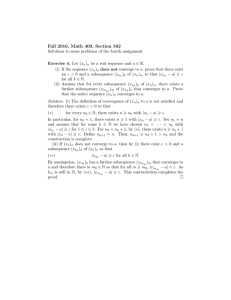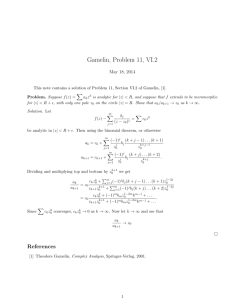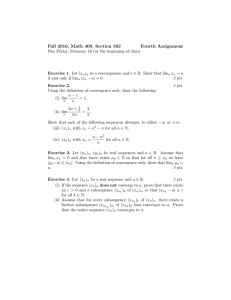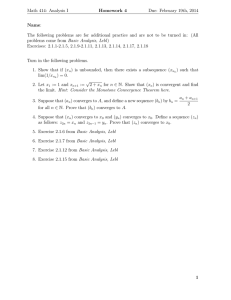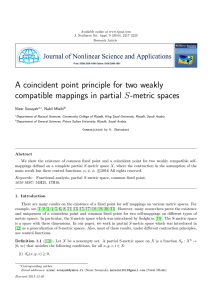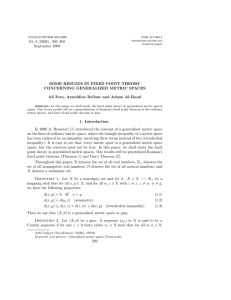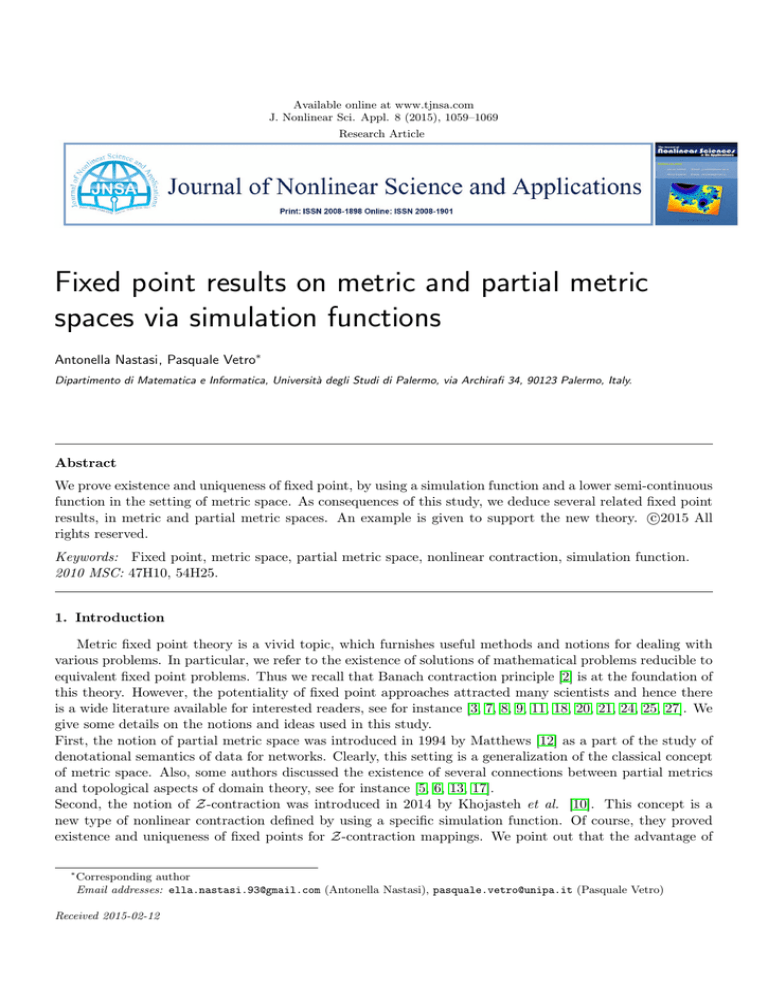
Available online at www.tjnsa.com
J. Nonlinear Sci. Appl. 8 (2015), 1059–1069
Research Article
Fixed point results on metric and partial metric
spaces via simulation functions
Antonella Nastasi, Pasquale Vetro∗
Dipartimento di Matematica e Informatica, Università degli Studi di Palermo, via Archirafi 34, 90123 Palermo, Italy.
Abstract
We prove existence and uniqueness of fixed point, by using a simulation function and a lower semi-continuous
function in the setting of metric space. As consequences of this study, we deduce several related fixed point
c
results, in metric and partial metric spaces. An example is given to support the new theory. 2015
All
rights reserved.
Keywords: Fixed point, metric space, partial metric space, nonlinear contraction, simulation function.
2010 MSC: 47H10, 54H25.
1. Introduction
Metric fixed point theory is a vivid topic, which furnishes useful methods and notions for dealing with
various problems. In particular, we refer to the existence of solutions of mathematical problems reducible to
equivalent fixed point problems. Thus we recall that Banach contraction principle [2] is at the foundation of
this theory. However, the potentiality of fixed point approaches attracted many scientists and hence there
is a wide literature available for interested readers, see for instance [3, 7, 8, 9, 11, 18, 20, 21, 24, 25, 27]. We
give some details on the notions and ideas used in this study.
First, the notion of partial metric space was introduced in 1994 by Matthews [12] as a part of the study of
denotational semantics of data for networks. Clearly, this setting is a generalization of the classical concept
of metric space. Also, some authors discussed the existence of several connections between partial metrics
and topological aspects of domain theory, see for instance [5, 6, 13, 17].
Second, the notion of Z-contraction was introduced in 2014 by Khojasteh et al. [10]. This concept is a
new type of nonlinear contraction defined by using a specific simulation function. Of course, they proved
existence and uniqueness of fixed points for Z-contraction mappings. We point out that the advantage of
∗
Corresponding author
Email addresses: ella.nastasi.93@gmail.com (Antonella Nastasi), pasquale.vetro@unipa.it (Pasquale Vetro)
Received 2015-02-12
A. Nastasi, P. Vetro, J. Nonlinear Sci. Appl. 8 (2015), 1059–1069
1060
this method is in providing a unique point of view for several fixed point problems; see recent results in
[1, 23].
Finally, Samet et al. [26], and Vetro and Vetro [28] discussed fixed point results by using semi-continuous
functions in metric spaces that generalize and improve many existing fixed point theorems in the literature.
As an application of presented results, the authors gave some theorems in the setting of partial metric spaces.
In this paper, we use the ideas in [26, 28] and the notion of simulation function to establish existence and
uniqueness of fixed points. As consequences of this study, we deduce several related fixed point results, in
metric and partial metric spaces. Also, an example is given to support the new theory.
2. Preliminaries
In this section we recall some definitions and some properties of partial metric spaces that can be found
in [12, 13, 14, 15, 16]. We start with a definition. Precisely, a partial metric on a non-empty set X is a
function p : X × X → [0, +∞[ such that, for all x, y, z ∈ X, we have
(p1 ) x = y ⇔ p(x, x) = p(x, y) = p(y, y),
(p2 ) p(x, x) ≤ p(x, y),
(p3 ) p(x, y) = p(y, x),
(p4 ) p(x, y) ≤ p(x, z) + p(z, y) − p(z, z).
Then, a partial metric space is a pair (X, p), where X is a non-empty set and p is a partial metric on
X. Notice that, if p(x, y) = 0, then from (p1 ) and (p2 ) it follows that x = y. However, if x = y, then p(x, y)
may not be 0. A classic example of partial metric space is the pair ([0, +∞[, p), where p(x, y) = max{x, y}
for all x, y ∈ [0, +∞[, see also [12].
Every partial metric p : X × X → [0, +∞[ generates a T0 topology τp on X which has as a base the
family of open p-balls {Bp (x, ε) : x ∈ X, ε > 0}, where
Bp (x, ε) = {y ∈ X : p(x, y) < p(x, x) + ε}
for all x ∈ X and ε > 0.
Let (X, p) be a partial metric space. A sequence {xn } in (X, p) converges to a point x ∈ X if and only
if p(x, x) = lim p(x, xn ). A sequence {xn } in (X, p) is called a Cauchy sequence if there exists (and is
n→+∞
finite)
lim
n,m→+∞
p(xn , xm ).
A partial metric space (X, p) is said to be complete if every Cauchy sequence {xn } in X converges, with
respect to τp , to a point x ∈ X such that p(x, x) = lim p(xn , xm ).
n,m→+∞
It is easy to see that, every closed subset of a complete partial metric space is complete.
Notice that if p is a partial metric on X, then the function ps : X × X → [0, +∞[ given by
ps (x, y) = 2p(x, y) − p(x, x) − p(y, y)
(2.1)
is a metric on X. Furthermore, lim ps (xn , x) = 0 if and only if
n→+∞
p(x, x) = lim p(xn , x) =
n→+∞
lim
n,m→+∞
p(xn , xm ).
Lemma 2.1. Let (X, p) be a partial metric space and let ϕ : X → [0, +∞[ be defined by ϕ(x) = p(x, x) for
all x ∈ X. Then the function ϕ is lower semi-continuous in the metric space (X, ps ).
A. Nastasi, P. Vetro, J. Nonlinear Sci. Appl. 8 (2015), 1059–1069
1061
Proof. Let {xn } ⊂ X be a sequence which converges to x ∈ X in the metric space (X, ps ), then
p(x, x) = lim p(xn , xn ) = lim inf p(xn , xn ).
n→+∞
n→+∞
It follows that ϕ is lower semi-continuous in x and hence in X.
Lemma 2.2 ([12, 14]). Let (X, p) be a partial metric space. Then
(a) {xn } is a Cauchy sequence in (X, p) if and only if it is a Cauchy sequence in the metric space (X, ps ).
(b) A partial metric space (X, p) is complete if and only if the metric space (X, ps ) is complete.
Khojasteh et al. gave the following definition of simulation function, see [10].
Definition 2.3. A simulation function is a mapping ζ : [0, +∞[×[0, +∞[→ R satisfying the following
conditions:
(ζ1 ) ζ(0, 0) = 0;
(ζ2 ) ζ(t, s) < s − t, for all t, s > 0;
(ζ3 ) if {tn }, {sn } are sequences in ]0, +∞[ such that limn→+∞ tn = limn→+∞ sn = ` ∈]0, +∞[, then
lim sup ζ(tn , sn ) < 0.
n→+∞
Consequently, they proved the following theorem.
Theorem 2.4 ([10]). Let (X, d) be a complete metric space and T : X → X be a Z-contraction with respect
to a certain simulation function ζ, that is,
ζ(d(T x, T y), d(x, y)) ≥ 0,
for all x, y ∈ X.
(2.2)
Then T has a unique fixed point. Moreover, for every x0 ∈ X, the Picard sequence {T n x0 } converges to this
fixed point.
In [1], Argoubi et al. note that the condition (ζ1 ) was not used for the proof of Theorem 2.4. Also
they observed that taking x = y in (2.2), one has ζ(0, 0) ≥ 0 and hence, if ζ(0, 0) < 0, the set of operators
T : X → X satisfying (2.2) is empty.
Therefore, Argoubi et al. slightly revised the previous definition, by withdrawing the condition (ζ1 ). For
the sake of clarity, we consider the following definition.
Definition 2.5. A simulation function is a mapping ζ : [0, +∞[×[0, +∞[→ R satisfying the conditions (ζ2 )
and (ζ3 ).
Note that every simulation function in (original) Khojasteh et al. sense (Definition 2.3) is a simulation
function in Argoubi et al. sense (Definition 2.5), but the converse is not true; see example below.
Example 2.6 ([1], Example 2.4). Let ζλ : [0, +∞[×[0, +∞[→ R be the function defined by
(
1
if (s, t) = (0, 0),
ζλ (t, s) =
λs − t otherwise,
where λ ∈]0, 1[. Then ζλ satisfies (ζ2 ) and (ζ3 ) with ζλ (0, 0) > 0.
For completeness we give some of the most interesting examples of simulation functions.
Example 2.7. Let ζ : [0, +∞[×[0, +∞[→ R, be defined by
(i) ζ(t, s) = λ s − t for all t, s ∈ [0, +∞[, where λ ∈ [0, 1[.
A. Nastasi, P. Vetro, J. Nonlinear Sci. Appl. 8 (2015), 1059–1069
1062
(ii) ζ(t, s) = ψ(s) − ϕ(t) for all t, s ∈ [0, +∞[, where ϕ, ψ : [0, +∞[→ [0, +∞[ are two continuous functions
such that ψ(t) = ϕ(t) = 0 if and only if t = 0 and ψ(t) < t ≤ ϕ(t) for all t > 0.
f (t, s)
t for all t, s ∈ [0, +∞[, where f, g : [0, +∞[×[0, +∞[→]0, +∞[ are two continuous
g(t, s)
functions with respect to each variable such that f (t, s) > g(t, s) for all t, s > 0.
(iii) ζ(t, s) = s −
(iv) ζ(t, s) = s − ψ(s) − t for all t, s ∈ [0, +∞[, where ψ : [0, +∞[→ [0, +∞[ is a lower semi-continuous
function such that ψ(t) = 0 if and only if t = 0.
(v) ζ(t, s) = sψ(s) − t for all t, s ∈ [0, +∞[, where ψ : [0, +∞[→ [0, 1[ is such that limt→r+ ψ(t) < 1 for all
r > 0.
3. Fixed points via simulation functions
We start this section with the following auxiliary lemma. Also, we use simulation function in the sense
of Definition 2.5. Let X 6= ∅, T : X → X, x0 ∈ X and xn = T xn−1 for all n ∈ N. Then {xn } is called
sequence of Picard of initial point at x0 .
Lemma 3.1. Let (X, d) be a metric space and let T : X → X be a mapping. Suppose that there exist a
simulation function ζ and a function ϕ : X → [0, +∞[ such that
ζ (d(T x, T y) + ϕ(T x) + ϕ(T y), d(x, y) + ϕ(x) + ϕ(y)) ≥ 0
for all x, y ∈ X.
(3.1)
Let {xn } be a sequence of Picard of initial point at x0 ∈ X. Suppose that xn−1 6= xn for all n ∈ N. Then
{xn } is a Cauchy sequence.
Proof. Let x0 be an arbitrary point in X and let {xn } be a sequence of Picard of initial point at x0 ∈ X.
We shall prove the lemma in three steps. The first step is to prove that
lim d(xn−1 , xn ) = 0
n→+∞
and
lim ϕ(xn ) = 0.
(3.2)
n→+∞
From, xn−1 6= xn for all n ∈ N, we deduce that
d(xn−1 , xn ) + ϕ(xn−1 ) + ϕ(xn ) > 0
for all n ∈ N.
Using (3.1) and (ζ2 ), with x = xn−1 and y = xn , we have
0 ≤ ζ(d(xn , xn+1 ) + ϕ(xn ) + ϕ(xn+1 ), d(xn−1 , xn ) + ϕ(xn−1 ) + ϕ(xn ))
< d(xn−1 , xn ) + ϕ(xn−1 ) + ϕ(xn ) − [d(xn , xn+1 ) + ϕ(xn ) + ϕ(xn+1 )]
for all n ∈ N. The above inequality shows that
d(xn , xn+1 ) + ϕ(xn ) + ϕ(xn+1 ) < d(xn−1 , xn ) + ϕ(xn−1 ) + ϕ(xn ),
for all n ∈ N,
which implies that {d(xn−1 , xn ) + ϕ(xn−1 ) + ϕ(xn )} is a decreasing sequence of positive real numbers. Thus,
there is some r ≥ 0 such that
lim d(xn−1 , xn ) + ϕ(xn−1 ) + ϕ(xn ) = r.
n→+∞
(3.3)
Suppose that r > 0. It follows from the condition (ζ3 ), with tn = d(xn , xn+1 ) + ϕ(xn ) + ϕ(xn+1 ) and
sn = d(xn−1 , xn ) + ϕ(xn−1 ) + ϕ(xn ), that
0 ≤ lim sup ζ (d(xn , xn+1 ) + ϕ(xn ) + ϕ(xn+1 ), d(xn−1 , xn ) + ϕ(xn−1 ) + ϕ(xn )) < 0,
n→+∞
A. Nastasi, P. Vetro, J. Nonlinear Sci. Appl. 8 (2015), 1059–1069
1063
which is a contradiction. Then we conclude that r = 0 and from (3.3), since ϕ ≥ 0, we get
lim d(xn−1 , xn ) = 0
n→+∞
and
lim ϕ(xn ) = 0.
n→+∞
The second step is to prove that the sequence {xn } is bounded. Let us assume that {xn } is not a bounded
sequence. Then, there exists a subsequence {xnk } of {xn } such that n1 = 1 and for each k ∈ N, nk+1 is the
minimum integer greater than nk such that
d(xnk+1 , xnk ) > 1
and
d(xm , xnk ) ≤ 1, for nk ≤ m ≤ nk+1 − 1.
By the triangle inequality, we obtain
1 < d(xnk+1 , xnk ) ≤ d(xnk+1 , xnk+1 −1 ) + d(xnk+1 −1 , xnk )
≤ d(xnk+1 , xnk+1 −1 ) + 1.
Letting k → +∞ in the above inequality and using (3.2), we get
lim d(xnk+1 , xnk ) = 1.
k→+∞
(3.4)
From
1 < d(xnk+1 , xnk ) ≤ d(xnk+1 , xnk+1 −1 ) + d(xnk+1 −1 , xnk −1 ) + d(xnk −1 , xnk )
and (3.2), we deduce that we can assume d(xnk+1 −1 , xnk −1 ) > 0 for all k ∈ N.
Again, from (3.1) and (ζ2 ), we deduce
1 < d(xnk+1 , xnk )
≤ d(xnk+1 , xnk ) + ϕ(xnk+1 ) + ϕ(xnk )
< d(xnk+1 −1 , xnk −1 ) + ϕ(xnk+1 −1 ) + ϕ(xnk −1 )
≤ d(xnk+1 −1 , xnk ) + d(xnk , xnk −1 ) + ϕ(xnk+1 −1 ) + ϕ(xnk −1 )
≤ 1 + d(xnk , xnk −1 ) + ϕ(xnk+1 −1 ) + ϕ(xnk −1 ).
Letting k → +∞ in the above inequality, using (3.2), we get
lim d(xnk+1 , xnk ) + ϕ(xnk+1 ) + ϕ(xnk ) = 1,
k→+∞
lim d(xnk+1 −1 , xnk −1 ) + ϕ(xnk+1 −1 ) + ϕ(xnk −1 ) = 1.
k→+∞
Then by condition (ζ3 ), with tk = d(xnk+1 , xnk ) + ϕ(xnk+1 ) + ϕ(xnk ) and sk = d(xnk+1 −1 , xnk −1 ) +
ϕ(xnk+1 −1 ) + ϕ(xnk −1 ), we obtain
0 ≤ lim sup ζ d(xnk+1 , xnk ) + ϕ(xnk+1 ) + ϕ(xnk ), d(xnk+1 −1 , xnk −1 ) + ϕ(xnk+1 −1 ) + ϕ(xnk −1 ) < 0,
k→+∞
which is a contradiction. Thus the sequence {xn } is bounded.
The third step is to prove that the sequence {xn } is Cauchy. To this end, let
Cn = sup{d(xi , xj ) : i, j ≥ n}, n ∈ N.
Since {xn } is bounded, we know that Cn < +∞ for every n ∈ N. Note that {Cn } is a positive non-increasing
sequence and hence there exists some C ≥ 0 such that
lim Cn = C.
n→+∞
(3.5)
A. Nastasi, P. Vetro, J. Nonlinear Sci. Appl. 8 (2015), 1059–1069
1064
Let us suppose that C > 0. By the definition of Cn , for every k ∈ N, there exist nk , mk ∈ N such that
mk > nk ≥ k and
1
Ck − < d(xmk , xnk ) ≤ Ck .
k
Letting k → +∞ in the above inequality, we get
lim d(xmk , xnk ) = C.
k→+∞
(3.6)
By (3.6), we can assume that d(xmk , xnk ) > 0 for all k ∈ N. From
d(xmk , xnk ) ≤ d(xmk , xmk −1 ) + d(xmk −1 , xnk −1 ) + d(xnk −1 , xnk ),
(3.2) and (3.6), we deduce that we can assume d(xmk −1 , xnk −1 ) > 0 for all k ∈ N.
Again, from (3.1), (3.2), (ζ2 ) and the definition of Cn , we deduce
d(xmk , xnk ) ≤ d(xmk , xnk ) + ϕ(xmk ) + ϕ(xnk )
≤ d(xmk −1 , xnk −1 ) + ϕ(xmk −1 ) + ϕ(xnk −1 )
≤ Ck−1 + ϕ(xmk −1 ) + ϕ(xnk −1 ).
Letting k → +∞ in the above inequality, using (3.2), (3.5) and (3.6), we obtain
lim d(xmk , xnk ) + ϕ(xmk ) + ϕ(xnk ) = C,
k→+∞
lim d(xmk −1 , xnk −1 ) + ϕ(xmk −1 ) + ϕ(xnk −1 ) = C.
k→+∞
By condition (ζ3 ), with tk = d(xmk , xnk ) + ϕ(xmk ) + ϕ(xnk ) and sk = d(xmk −1 , xnk −1 ) + ϕ(xmk −1 ) +
ϕ(xnk −1 ), we get
0 ≤ lim sup ζ(d(xmk , xnk ) + ϕ(xmk ) + ϕ(xnk ), d(xmk −1 , xnk −1 ) + ϕ(xmk −1 ) + ϕ(xnk −1 )) < 0,
k→+∞
which is a contradiction. Thus we have C = 0 and this ensures that {xn } is a Cauchy sequence.
Now, we present our first main result inspired to the papers [10, 26, 28].
Theorem 3.2. Let (X, d) be a complete metric space and let T : X → X be a mapping. Suppose that there
exist a simulation function ζ and a lower semi-continuous function ϕ : X → [0, +∞[ such that (3.1) holds,
that is,
ζ (d(T x, T y) + ϕ(T x) + ϕ(T y), d(x, y) + ϕ(x) + ϕ(y)) ≥ 0 for all x, y ∈ X.
Then T has a unique fixed point z such that ϕ(z) = 0.
Proof. Let x0 ∈ X and {xn } be a sequence of Picard with initial point at x0 . At first, observe that if
xm = xm+1 for some m ∈ N, then xm = xm+1 = T xm , that is, xm is a fixed point of T . In this case, the
existence of a fixed point is proved. Therefore, we can suppose that xn 6= xn+1 for every n ∈ N.
Now, by Lemma 3.1, the sequence {xn } is Cauchy and since (X, d) is complete, then there exists some
z ∈ X such that
lim xn = z.
(3.7)
n→+∞
Note that first step of Lemma 3.1 and lower semi-continuity of the function ϕ give
0 ≤ ϕ(z) ≤ lim inf ϕ(xn ) = 0,
n→+∞
that is, ϕ(z) = 0.
A. Nastasi, P. Vetro, J. Nonlinear Sci. Appl. 8 (2015), 1059–1069
1065
We claim that z is a fixed point of T . If there exists a subsequence xnk of xn such that xnk = z or
T xnk = T z for all k ∈ N, then z is a fixed point for T . If this does not occur, then we can assume that
xn 6= z and T xn 6= T z for all n ∈ N. Using (3.1) and (ζ2 ) with x = xn and y = z, we deduce that
0 ≤ ζ(d(T xn , T z) + ϕ(T xn ) + ϕ(T z), d(xn , z) + ϕ(xn ) + ϕ(z))
< d(xn , z) + ϕ(xn ) + ϕ(z) − [d(T xn , T z) + ϕ(T xn ) + ϕ(T z)].
This implies
d(T xn , T z) + ϕ(T xn ) + ϕ(T z) < d(xn , z) + ϕ(xn ) + ϕ(z)
for all n ∈ N
and consequently
d(z, T z) ≤ d(z, xn+1 ) + d(T xn , T z)
≤ d(z, xn+1 ) + d(T xn , T z) + ϕ(T xn ) + ϕ(T z)
< d(z, xn+1 ) + d(xn , z) + ϕ(xn ) + ϕ(z)
for all n ∈ N. Letting n → +∞ in the above inequality, we obtain that d(z, T z) = 0, that is, z = T z.
Now, we establish uniqueness of the fixed point. Suppose that there exists w ∈ X such that w = T w
and z 6= w. Using (3.1) and (ζ2 ) with x = w and y = z, we get that
0 ≤ ζ(d(f w, f z) + ϕ(w) + ϕ(z), d(w, z) + ϕ(w) + ϕ(z)) < d(w, z) − d(w, z) = 0,
which ia a contradiction and hence w = z. This ends the proof of Theorem 3.2.
4. Consequences
We show the unifying power of simulation functions by applying Theorem 3.2 to deduce different kinds
of contractive conditions in the existing literature.
The following corollary is a result of Banach type [2].
Corollary 4.1. Let (X, d) be a complete metric space and let T : X → X be a mapping. Suppose that there
exist λ ∈]0, 1[ and a lower semi-continuous function ϕ : X → [0, +∞[ such that
d(T x, T y) + ϕ(T x) + ϕ(T y) ≤ λ d(x, y) + ϕ(x) + ϕ(y)
for all x, y ∈ X.
Then T has a unique fixed point.
Proof. The result follows from Theorem 3.2, by taking as simulation function
ζ(t, s) = λ s − t,
for all t, s ≥ 0.
Note that we obtain Banach contraction principle if we assume ϕ(x) = 0 for all x ∈ X.
The following corollary is a result of Rhoades type [22].
Corollary 4.2. Let (X, d) be a complete metric space and let T : X → X be a mapping. Suppose that there
exist two lower semi-continuous functions ψ : [0, +∞[→ [0, +∞[ with ψ −1 (0) = {0} and ϕ : X → [0, +∞[
such that
d(T x, T y) + ϕ(T x) + ϕ(T y) ≤ d(x, y) + ϕ(x) + ϕ(y) − ψ(d(x, y) + ϕ(x) + ϕ(y))
Then T has a unique fixed point.
for all x, y ∈ X.
A. Nastasi, P. Vetro, J. Nonlinear Sci. Appl. 8 (2015), 1059–1069
1066
Proof. The result follows from Theorem 3.2, by taking as simulation function
ζ(t, s) = s − ψ(s) − t,
for all t, s ≥ 0.
We have also the following corollary, see [19].
Corollary 4.3. Let (X, d) be a complete metric space and let T : X → X be a mapping. Suppose that there
exist a function ψ : [0, +∞[→ [0, 1[ with lim supt→r+ ψ(t) < 1 for all r > 0 and a lower semi-continuous
function ϕ : X → [0, +∞[ such that
d(T x, T y) + ϕ(T x) + ϕ(T y) ≤ ψ(d(x, y) + ϕ(x) + ϕ(y)) [d(x, y) + ϕ(x) + ϕ(y)]
for all x, y ∈ X.
Then T has a unique fixed point.
Proof. The result follows from Theorem 3.2, by taking as simulation function
ζ(t, s) = sψ(s) − t,
for all t, s ≥ 0.
The following corollary is a result of Boyd-Wong type [4].
Corollary 4.4. Let (X, d) be a complete metric space and let T : X → X be a mapping. Suppose that there
exist an upper semi-continuous function η : [0, +∞[→ [0, +∞[ with η(t) < t for all t > 0 and η(0) = 0 and
a lower semi-continuous function ϕ : X → [0, +∞[ such that
d(T x, T y) + ϕ(T x) + ϕ(T y)) ≤ η(d(x, y) + ϕ(x) + ϕ(y)))
for all x, y ∈ X.
Then T has a unique fixed point.
Proof. The result follows from Theorem 3.2, by taking as simulation function
ζ(t, s) = η(s) − t,
for all t, s ≥ 0.
Note that we obtain Boyd-Wong result if we assume ϕ(x) = 0 for all x ∈ X.
Next example shows that Theorem 3.2 is a proper generalization of both Banach contraction principle
and Boyd-Wong result in the setting of metric spaces.
Example 4.5 ([28], Example 4). Let X = [0, 1] endowed with the usual metric d(x, y) = |x − y| for all
x, y ∈ X. Obviously (X, d) is a complete metric space. Also, fix r ∈ [0, 1[, and define T : X → X by
0
if x = 0,
r
2n−1
1
1
Tx =
2n − r 2n (2nx − 1) if 2n ≤ x ≤ 2n−1 ,
r
2n+1
1
1
2n + r 2n (2nx − 1) if 2n+1 ≤ x ≤ 2n .
Firstly, we prove that T is not a contraction. In fact, if for odd n > 1 we choose x =
we have
r
n
3
d(T x, T y) =
≤ d(x, y) =
≤
,
n−1
(n − 1)(2n − 1)
5(n − 1)
1
2n−1
and y =
1
n−1 ,
A. Nastasi, P. Vetro, J. Nonlinear Sci. Appl. 8 (2015), 1059–1069
1067
which is not satisfied for r > 3/5. Therefore, both the Banach contraction principle and Boyd-Wong result
cannot be applied.
On the other hand, if we consider the function φ : X → [0, +∞[ defined by φ(x) = x, then we obtain
d(T x, T y) + φ(T x) + φ(T y) = 2 max{T x, T y}
≤ 2 max{rx, ry}
= r2 max{x, y}
= r[d(x, y) + φ(x) + φ(y)],
for all x, y ∈ X. Thus, all the conditions of Corollary 4.1 are satisfied. Therefore, T has a unique fixed point
in X.
5. Fixed points in partial metric spaces
In this section, from our Theorem 3.2, we deduce easily various fixed point theorems on partial metric
spaces including the Matthews fixed point theorem.
Theorem 5.1. Let (X, p) be a complete partial metric space and let T : X → X be a mapping. Suppose
that there exists a simulation function ζ such that
ζ (p(T x, T y), p(x, y)) ≥ 0
for all x, y ∈ X.
(5.1)
Then T has a unique fixed point z ∈ X such that p(z, z) = 0.
Proof. From (2.1), we deduce that
p(x, y) =
ps (x, y) + p(x, x) + p(y, y)
2
for all x, y ∈ X.
(5.2)
By Lemma 2.2, the metric space (X, 2−1 ps ) is complete since (X, p) is complete. Also, by Lemma 2.1, the
function ϕ : X → [0, +∞[ defined by ϕ(x) = 2−1 p(x, x) is lower semi-continuous in (X, 2−1 ps ). Now, from
(5.1) and (5.2), we obtain that the mapping T satisfies the following contractive condition
ζ 2−1 ps (T x, T y) + ϕ(T x) + ϕ(T y), 2−1 ps (x, y) + ϕ(x) + ϕ(y) ≥ 0 for all x, y ∈ X.
Thus the mapping T satisfies all the condition of Theorem 3.2 with respect to the metric space (X, 2−1 ps ),
and hence has a unique fixed point z ∈ X such that p(z, z) = 2 ϕ(z) = 0.
Now, the Matthews fixed point theorem follows immediately from Theorem 5.1 by chosing as simulation
function
ζ(t, s) = λs − t for all t, s ∈ [0, +∞[
with λ ∈ [0, 1[.
Corollary 5.2. Let (X, p) be a complete partial metric space and let T : X → X be a mapping. Suppose
that there exists a λ ∈ [0, 1[ such that
p(T x, T y) ≤ λ p(x, y)
for all x, y ∈ X.
(5.3)
Then T has a unique fixed point z ∈ X such that p(z, z) = 0.
If we choose as simulation function
ζ(t, s) = η(s) − t
for all t, s ∈ [0, +∞[
where η : [0, +∞[→ [0, +∞[ is an upper semi-continuous function with η(t) < t for all t > 0 and η(0) = 0,
then we obtain the following result of Boyd-Wong type in the setting of partial metric space.
A. Nastasi, P. Vetro, J. Nonlinear Sci. Appl. 8 (2015), 1059–1069
1068
Corollary 5.3. Let (X, p) be a complete partial metric space and let T : X → X be a mapping. Suppose
that there exists an upper semi-continuous function η : [0, +∞[→ [0, +∞[ with η(t) < t for all t > 0 and
η(0) = 0 such that
d(T x, T y) ≤ η(d(x, y) for all x, y ∈ X.
Then T has a unique fixed point.
Appropriately choosing the simulation function we can obtain other known results of fixed point in
partial metric spaces.
References
[1] H. Argoubi, B. Samet, C. Vetro, Nonlinear contractions involving simulation functions in a metric space with a
partial order, (submitted). 1, 2, 2.6
[2] S. Banach, Sur les opérations dans les ensembles abstraits et leur application aux équations intégrales, Fund.
Math., 3 (1922), 133–181. 1, 4
[3] V. Berinde, Generalized contractions in quasimetric spaces, Seminar on Fixed Point Theory, Babe-Bolyai Univ.
Cluj-Napoca, 3 (1993), 3–9. 1
[4] D. W. Boyd, J. S. W. Wong, On nonlinear contractions, Proc. Amer. Math. Soc., 20 (1969), 458–464. 4
[5] M. A. Bukatin, J. S. Scott, Towards computing distances between programs via Scott domains, Logical Foundations
of Computer Science, Lecture Notes in Compt. Sci. Springer Berlin, 1234 (1997), 33–43. 1
[6] M. A. Bukatin, S. Y. Shorina, Partial metrics and co-continuous valuations, Foundations of Software Science
and Computation Structures, Lecture Notes in Computer Science (ed. M. Nivat), Springer Berlin, 1378 (1998),
33–43. 1
[7] L. Ćirić, B. Samet, C. Vetro, Common fixed point theorems for families of occasionally weakly compatible mappings,
Math. Comput. Modelling, 53 (2011), 631–636. 1
[8] L. Ćirić, B. Samet, C. Vetro, M. Abbas, Fixed point results for weak contractive mappings in ordered K-metric
spaces, Fixed Point Theory, 13 (2012), 59–72. 1
[9] M. Cosentino, P. Salimi, P. Vetro, Fixed point results on metric-type spaces, Acta Math. Sci. Ser. B Engl. Ed.,
34 (2014), 1237–1253. 1
[10] F. Khojasteh, S. Shukla, S. Radenović, A new approach to the study of fixed point theorems via simulation
functions, Filomat, (2014), in press. 1, 2, 2.4, 3
[11] V. Lakshmikantham, L. Ćirić, Coupled fixed point theorems for nonlinear contractions in partially ordered metric
spaces, Nonlinear Anal., 70 (2009), 4341–4349. 1
[12] S. G. Matthews, Partial metric topology, Proc. 8th Summer Conference on General Topology and Applications,
Ann. New York Acad. Sci., 728 (1994), 183–197. 1, 2, 2.2
[13] S. J. O’Neill, Partial metrics, valuations and domain theory, Conference on General Topology and Applications,
Ann. New York Acad. Sci., 806 (1996), 304–315. 1, 2
[14] S. Oltra, O. Valero, Banach’s fixed point theorem for partial metric spaces, Rend. Istit. Mat. Univ. Trieste, 36
(2004), 17–26. 2, 2.2
[15] D. Paesano, P. Vetro, Suzuki’s type characterizations of completeness for partial metric spaces and fixed points
for partially ordered metric spaces, Topology Appl., 159 (2012), 911–920. 2
[16] S. Romaguera, A Kirk type characterization of completeness for partial metric spaces, Fixed Point Theory Appl.,
2010 (2010), 6 pages. 2
[17] S. Romaguera, M. Schellekens, Partial metric monoids and semivaluation spaces, Topology Appl., 153 (2005),
948–962. 1
[18] D. Reem, S. Reich, A. J. Zaslavski, Two Results in Metric Fixed Point Theory, J. Fixed Point Theory Appl., 1
(2007), 149–157. 1
[19] S. Reich, Fixed points of contractive functions, Boll. Un. Mat. Ital., 5 (1972), 26–42. 4
[20] S. Reich, A. J. Zaslavski, A Fixed Point Theorem for Matkowski Contractions, Fixed Point Theory, 8 (2007),
303–307. 1
[21] S. Reich, A. J. Zaslavski, A Note on Rakotch contraction, Fixed Point Theory, 9 (2008), 267–273. 1
[22] B. E. Rhoades, Some theorems on weakly contractive maps, Nonlinear Anal., 47 (2001), 2683–2693. 4
[23] A. Roldán, E. Karapinar, C. Roldán, J. Martı́nez-Moreno, Coincidence point theorems on metric spaces via
simulation functions, J. Comput. Appl. Math., 275 (2015), 345–355. 1
[24] I. A. Rus, Generalized Contractions and Applications, Cluj University Press, Cluj-Napoca, (2001). 1
[25] I. A. Rus, A. Petruşel, G. Petruşel, Fixed Point Theory, Cluj University Press, Cluj-Napoca, (2008). 1
[26] B. Samet, C. Vetro, F. Vetro, From metric spaces to partial metric spaces, Fixed Point Theory Appl., 2013
(2013), 11 pp. 1, 3
[27] C. Vetro, F. Vetro, Common fixed points of mappings satisfying implicit relations in partial metric spaces, J.
Nonlinear Sci. Appl., 6 (2013), 152–161. 1
A. Nastasi, P. Vetro, J. Nonlinear Sci. Appl. 8 (2015), 1059–1069
1069
[28] C. Vetro, F. Vetro, Metric or partial metric spaces endowed with a finite number of graphs: a tool to obtain fixed
point results, Topology Appl., 164 (2014), 125–137. 1, 3, 4.5

